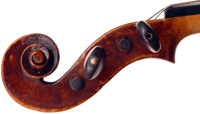|
Ref : 0837
A very good and interesting
|

go to Home Page see more Violins |
This violin, labelled Sebastian Kloz and dated 1772 by hand was acquired in Lisbon in 1972 from the noted Portuguese violinmaker, Antonio Capela (b. 1932), whose bridge it still bears. The particular label used in this violin was commonly used by the different branches of the large and extended Klotz family. However, experts at Sothebys in London determined that it is not the work of Sebastian Kloz, but that it is likely from that family.Several things strike one immediately about this violin, Firstly, that it is genuinely old and certainly from around 1770. Secondly, that it is in superb condition for an instrument of that era - other than a repaired crack directly under the chinrest (and hidden by it) there are no significant cracks anywhere in the top. A wingcrack to the bass F (common in old instruments) has been repaired and there are absolutely no cracks near the bridge and soundpost areas. The back is completely free from cracks and a minor wood graft was done into the lower treble rib, where it meets the top. An internal examination also shows that some of the linings meeting the top have been replaced. It can be assumed that all this restorative work was carried out by Capela, who at that time was highly respected as restorer, having studied that craft with Etienne Vatelot in Paris. Furthermore, it seems that the varnish is original in its entirety, although it has likely been touched up slightly in places.
Also striking is the exceptionally narrow growth lines in the top wood. This is some of the finest wood I have ever seen in a top - very likely grown in a very cold place at high altitude. The maple ribs, back and scroll are somewhat plain in appearance, demonstrating an penchant for what functions well rather than for what is pretty, but of excellent quality. This violin has a good neck graft and some pegholes are rebushed. An interesting feature is a small mortise cut through the back of the pegbox (see photo). This was likely not by the maker, but added later. Apparently the purpose of the hole was to hang the violin to a small hook that was especially provided on orchestra music stands at that time, but whether that is true or not is not clear.
Finally, this violin is very well toned with a clear, strong and clean sound, well-balanced across the strings and through all positions - superbly suited for chamber music performance. It has been in high-level professional use for the past 40 years and the hope is to find a musician who would appreciate its excellent qualities and perpetuate its use on the stage, where it belongs.
 |
 |
 |
||
 |
Dimensions : 35.7 cm
Condition : Excellent condition, fully refurbished in 1772 in Lisbon by Antonio Capela. No cracks near the bridge and soundpost areas. Wingcrack to bass F repaired. Some pegholes rebushed. Small graft to lower treble rib. Short crack in the top, under the chinrest, is repaired and correctly cleated internally. Some linings inside have been replaced. Excellent neck graft. The varnish is the original.
Provenance : Acquired in Lisbon in 1972 from Antonio Capela. Examined by Sothebys in same year. Current ownership withheld
Price : P.O.A.
 |
 |
 |
 |
 |
 |
 |
 |
 |
 |
 |
 |
|||||
 |
 |
 |